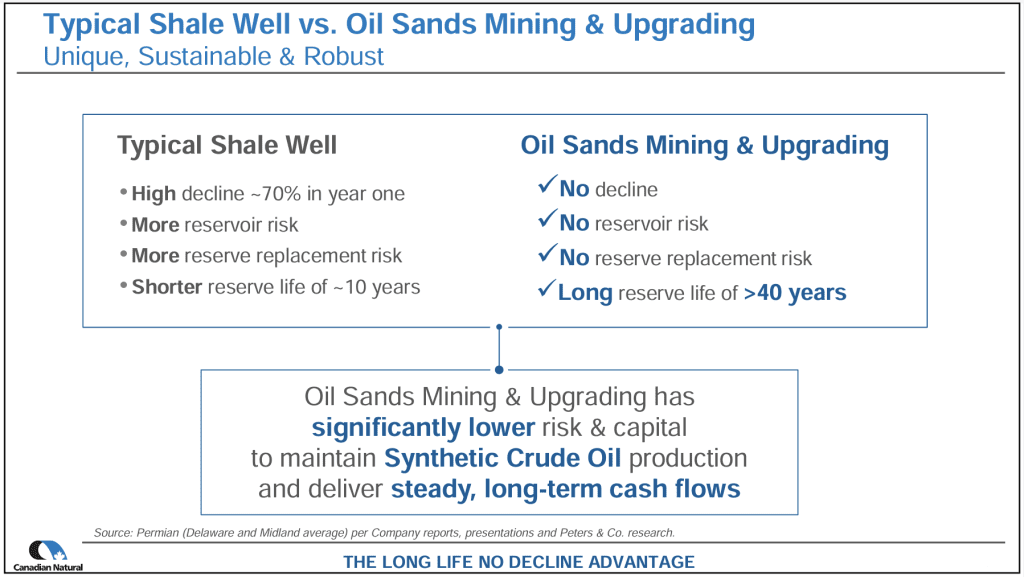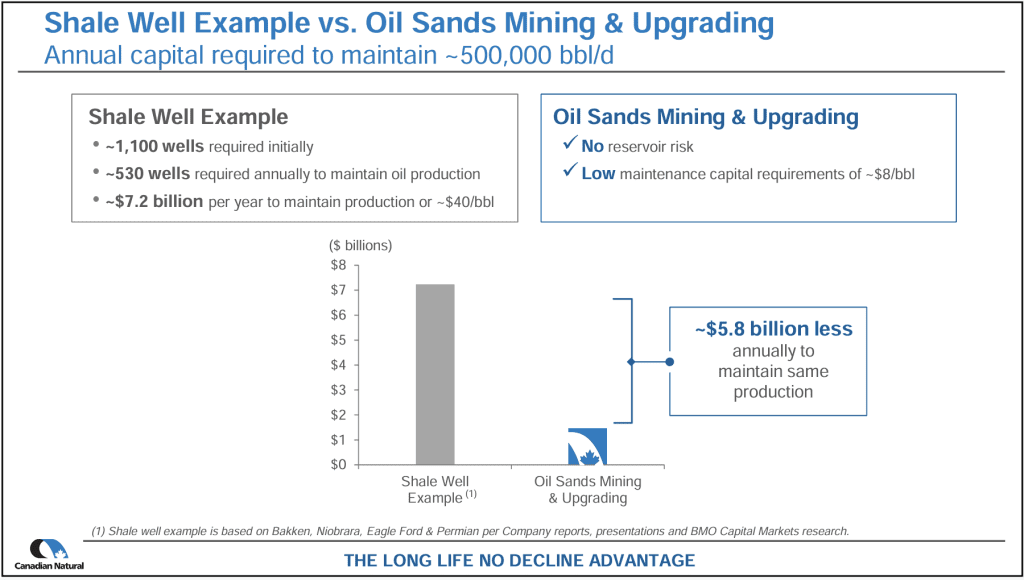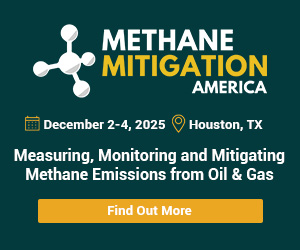Canada’s secret energy advantage: long life, no decline
By Stewart Muir
Oil and gas fields almost everywhere face natural decline. Shale wells lose about 70 per cent of their output in the first year. Many conventional reservoirs also taper off, often in the range of 5 to 7 per cent annually, though actual decline rates vary widely depending on geology and field management. The result is that nearly 90 per cent of global upstream spending now goes simply to replacing lost supply.
Birol estimates that it is taking about $500 billion a year just to keep the industry running in place. If that stopped, the world would lose the equivalent of Brazil’s and Norway’s combined production every year. That’s how steep the slope has become.
Which brings us to Canada’s quiet advantage. Our oil sands — especially the mining and upgrading projects in northern Alberta — don’t behave like shale. Once built, they produce steadily for forty years or more. No frantic drilling treadmill. No production cliff.
Oil sands insiders call this the “long life, no decline” advantage.
It may sound like inside baseball. But in energy economics, this distinction is huge. In fact, it’s so critical that one of the nation’s largest energy producers, Calgary’s Canadian Natural Resources, recently devoted an entire investor slide to it, spelling out the contrast between shale and oil sands. When a major company takes the trouble to educate even sophisticated investors, you start to suspect the point isn’t as widely understood as it should be.


Another underappreciated benefit of this advantage is what it makes possible on the decarbonization front. Because oil sands production is steady for decades, these assets provide a stable platform to deploy major emissions-reduction technologies — carbon capture and storage, small modular nuclear reactors, advanced heat recovery. These are not quick fixes; they require billions in upfront capital and long timelines to pay back. That kind of commitment makes little sense if your underlying resource base is collapsing year after year. Canada’s stability means we can make those big bets. When Prime Minister Mark Carney refers to “decarbonized oil”, some might dismiss that as magical thinking, but I’m pretty sure what he means is oil sands deposits that can be subject to long-term, intensive efforts to do all of these things – a luxury not available to those whose eggs are all in the drilling basket.
But there’s a bigger geopolitical conversation here. Surely if the United States wants to secure abundant oil in its own “backyard,” the logical step would be to ensure there is enough pipeline capacity from Canada. We’ve been here before with Keystone XL. The project became a political lightning rod, but the fundamental logic has not changed: the U.S. and their refineries will need reliable long-life oil for decades to come. Canada has it. The question is whether Washington is prepared to act in its own strategic interest.
That means the long life, no decline message is not just an investor presentation footnote. It’s a fact that needs to be recognized in Ottawa, in Washington, and across the Canadian public. In Ottawa, because policymakers must grasp that the oil sands are the crown jewel of Canada’s resource economy.
What Washington needs to keep front of mind is that Canada is not just a friendly neighbour — we are a cornerstone of North American energy security. Canadians, whose views have been shaped by years of opposition campaigns that tried to make us ashamed of the oil sands, seem to be open again to the possibility that energy is more complicated that polarized public debates often make out.
Frankly, Canadians should hold the oil sands in higher esteem. The more I see how the world really works, the prouder I am of this resource.
The understand in more detail what this long life, no decline phrase is all about, think of it this way. For decades, the global oil system has resembled hunting and gathering. Companies poke holes in the ground, chase short-lived wells, and then move on to the next patch. Technology has reduced the uncertainty, but the feel is still primitive — like a parent rushing to the corner store every night for a quart of milk. It works, but it’s expensive, unreliable, and not built for the long haul.
Canada’s oil sands are the opposite. They are the Costco of energy: a big-box supply that doesn’t run out after one trip. Instead of scrambling for the next well, the resource is completely known, concentrated in one place, and designed for decades of steady output. That allows entire communities, supply chains, railroads, and international ports to grow around it. The oil sands are less like hunting and more like a factory — stable, predictable, and always in stock.
If Costco can sell loyalty with a simple membership card, why can’t we brand Canada’s enduring energy advantage just as boldly?
Great observers of energy markets like Daniel Yergin and Anas Alhajji have hinted at this for years: decline is relentless, durable resources are rare, and those who hold them wield strategic power. The IEA’s latest report confirms it. Four out of five barrels of oil today come from fields already past peak. Nine out of ten cubic metres of natural gas come from the same category. The world isn’t just chasing new demand growth — it’s sprinting to replace what geology is taking away.
And indicators are that American oil producers sense the easy years of global oil dominance are fading fast. “The US shale business is broken,” said one executive recently, according to the Financial Times. “What was once the world’s most dynamic energy engine has been gutted by political hostility and economic ignorance.”
That’s why Canada’s message has to be clear and confident. This is not the time to downplay the value of our oil sands. It’s time to explain, unapologetically, that in a world of decline, Canada’s long-life, no-decline resources are indispensable.
Share This:




 CDN NEWS |
CDN NEWS |  US NEWS
US NEWS 






























